Introduction
In this application note we show the application of a modified luminescent firefly luciferase based on Promega 's GloSensor. cAMP experiment. Detection of cAMP levels was performed in the FLIPR.Tetra high throughput screening system to ensure accurate detection of Gi and Gs coupled GPCR activity in kinetic mode . Through such experiments, GPCR subtypes can be evaluated based on detection of changes in intracellular correlated second messenger cAMP concentrations . Traditional methods for the detection of second messenger signal activity of Gi and Gs coupled GPCRs generally employ end-point cAMP assays that employ radioactive binding or require cell lysis . These types of experiments are all about detecting cellular responses and activities at a single time point and do not provide kinetic information. In another alternative , Gs- and Gi-GPCRs , which are forcibly coupled to G Þ 16 , are used to detect fluorescence signal detection by calcium ion flux after receptor activation. However, this method can only be used as a second choice because it is not a direct response to the cAMP pathway bio-related signal changes. We demonstrate endogenous receptor activity in CHO-K1 and HEK-293 cell lines stably expressing the Glosensor plasmid . In addition, stably transfected Gs- and Gi- coupled receptor activities were detected in cell lines transiently transfected with the Glosensor plasmid . Combined with the Glosensor cAMP method, the FLIPR Tetra system has established a flexible and complete solution for the dynamic screening of major subtypes of GPCRs .
As shown in Figure 1 , the Glosensor cAMP assay was performed primarily by fusion of the cAMP binding domain to the N- and C- termini of wild-type firefly luciferase . In the absence of cAMP , the genetically modified luciferase containing the cAMP binding domain is in an inactive state. Once cAMP is bound , a change in the conformation of the cAMP- binding domain is activated, causing an increase in the chemiluminescent signal, which is detected by the FLIPRTetra system. More information on the Glosensor cAMP experiment can be found in the technical manual ( Cat# TM076, Promega ).
Flexible Gs- and Gi- coupled GPCR experimental designs that combine plasmid transient transfection or stable transfection are feasible. Four alternative cell lines or target cell lines from Promega are listed below:
Flexible GloSensor cAMP experimental design
Stable receptor and stable GloSensor cAMP assay
Transient receptor and stable GloSensor cAMP assay
Stable receptor and transient GloSensor cAMP assay
Transient receptor and transient GloSensor cAMP assay
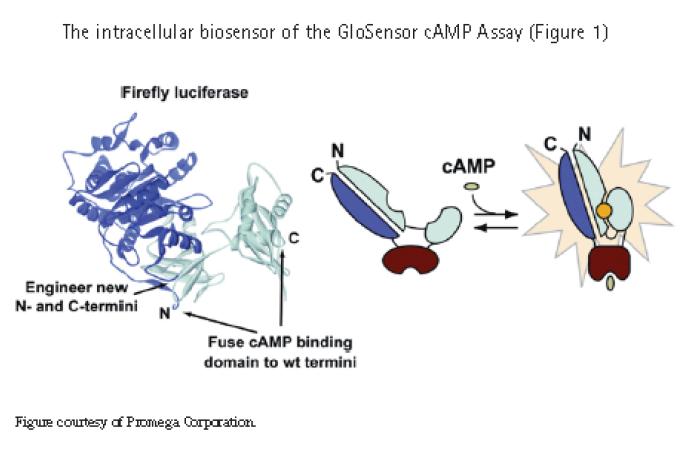
FLIPR Tetra system:
• Ultra-sensitive ICCD cameras can detect both chemiluminescence and fluorescent signals
• Dynamic cAMP luminescence signal detection in live cells is achieved by the FLIPRTetra system's ultra-sensitive ICCD camera
• Experimental throughput : 96-, 384- and 1536- well recording board specifications for easy integration with automation equipment
materialcAMP cell line and plasmid
• GloSensor cAMP HEK 293 stable cell line (Promega Corporation, Cat. #E1261)
• GloSensor cAMP 23F CHO K1-stable cell line (Promega R&D)
• Rat Y2R/GloSensor cAMP 23F CHO-K1 double stable cell line (Promega R&D)
• GloSensor cAMP assay plasmid pGlosensor-22FcAMP (Promega, Cat. #E2301)
• Dopamine D4 stable HEK 293T cell line (Multispan Inc., Cat. #C1338)
Cell culture reagent
HEK 293 cell growth medium: 90% DMEM (Life Technologies, Cat. #11995- 065), 10% FBS (Hyclone, Cat. #SH.30071), 200 μg/mL hygromycin B (Sigma, Cat. #H3274)
GloSensor cAMP-23F CHO-K1 cell growth medium: 90% F-12 Medium (Life Technologies, Cat. #11765), 10% FBS, and 200 mg/mL hygromycin B)
Glo Sensor cAMP-23F/Y2R CHO-K1 double stable cell growth medium: 90% F-12 Medium (Life Technologies, Cat. #11765), 10% FBS, and 200 μg/mL hy- gromycin B), and 500 Gg/mL G418 (Life Technologies, Cat. #10131027)
Experimental reagent
• Plating medium: 90% CO2-independent medium (Life Technologies, Cat. #18045), 10% FBS
• HEPES buffer: Re-suspend HEPES in deionized water to 10 mM; adjust pH to7.5 using KOH
• GloSensor cAMP Reagent stock solution: Re-suspend 250 mg GloSensor cAMP Reagent (Promega, Cat. #E1291) in 8.17 mL of HEPES buffer; store at -70°C in single-use aliquots
• Balance solution: planting solution (see above) and 2% or 5% GloSensor cAMP reagent; optimized according to specific experimental conditions • Compound: (-) isoproterenol (. Sigma, Cat # I6504) ; salbutamol (. Sigma, Cat # S8260) ; propranolol (. Sigma, Cat # P0884) ; pindolol (Sigma, Cat. #P0778); Apollo (Sigma, Cat. #A8676); Dopamine (Sigma, Cat. # H8502). Peptide YY(3-36), (Tocris Cat. #1618); All Compounds The mother liquor is configured at 10 mM and added with HBSS + 20 mM HEPES for further dilution
method
Stable GloSensor cAMP cell line assay
Step 1. Cells were cultured overnight in a 384- well black-walled cell plate ( Coring, Cat. #3712 ).
Step 2. 2 hours before the experiment, the medium was removed and incubated at 37 ° C for the cells in 5% CO2 and 1 hour and then added to each well balanced solution containing 30 Glosensor cAMP μ L reagent at room temperature for 1 hour.
• HEK cells are incubated in an equilibration solution containing 2% Glosensor cAMP reagent
• CHO-K1 cells are incubated in 5% Glosensor cAMP reagent
Step 3. Add 5X compound through FLIPRTetra system during kinetic detection
Step 4. Exposure every 10 or 30 seconds for 10-25 minutes
Step 5. In general, Gi- coupled receptor experiments take longer due to lower kinetic changes . The FLIPR parameter settings are shown in Table 1.
Step 6. Data results were exported from FLIPR 's ScreenWorks® software to Graphpad Prism 5 for analysis
GloSensor cAMP transient transfection method for cells stably expressing GPCR receptor cells and endogenous receptors
Step 1. Incubate the cells in culture flasks at 37 ° C and 5% CO 2 without antibiotics , and the density can reach 70-80% .
Step 2. Opti-Mem- diluted in serum-free medium pGloSensor cAMP plasmid to 20 ng / mL, such that step 4 cells per ml system containing 1- μ g DNA / mL (Life Technologies, Cat. # 31985).
Step 3. Add Fugene HD Transfection Reagent Mixture ( Roche, Cat. #0409705001 ) at a ratio of 3:1 per microgram of DNA and gently mix for 15 minutes at room temperature . Ratio of reagent (μ L) and DNA (μ G) is 3: 1.
Step 4. DNA complexes was added to cells containing 0.48 million per mL centrifuge tube (time of planting 12000 cells / 25 μ L / well for HEK-D4; depending on the cell).
Step 5. According to different cell lines, implant 8000 - 12000 cells in 25 microliters per well and incubate for 2 days at 37 ° C and 5% CO2 .
Step 6. day of the experiment medium was removed and gently added 30 μ L 2 - 6% f / v GloSensor cAMP agent to the equilibrium solution.
Step 7. Incubate for 1 hour at 37 ° C and leave at room temperature for 1 hour.
Step 8. Referring to the parameter settings of the FLIPR system in Table 1 , add 6X compound during the kinetic detection .
Table 1: FLIPR Tetra System Setup Parameters
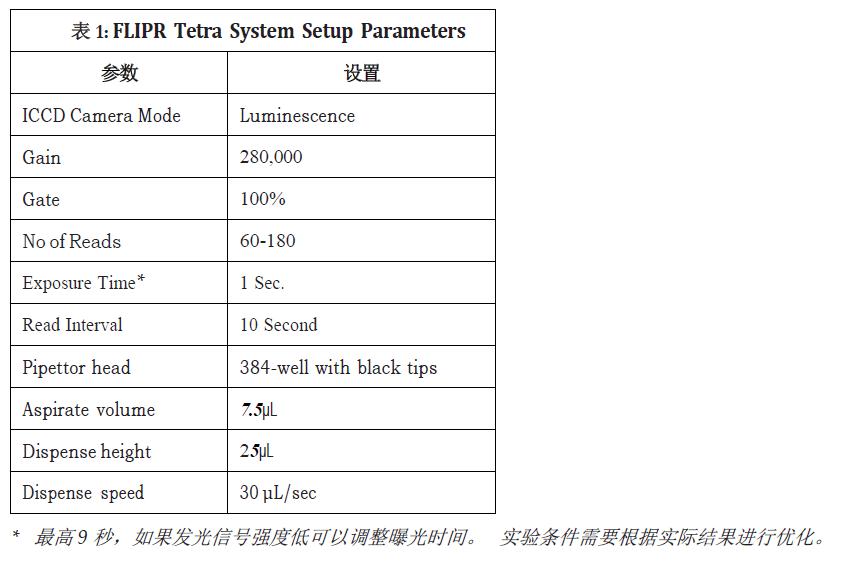
result
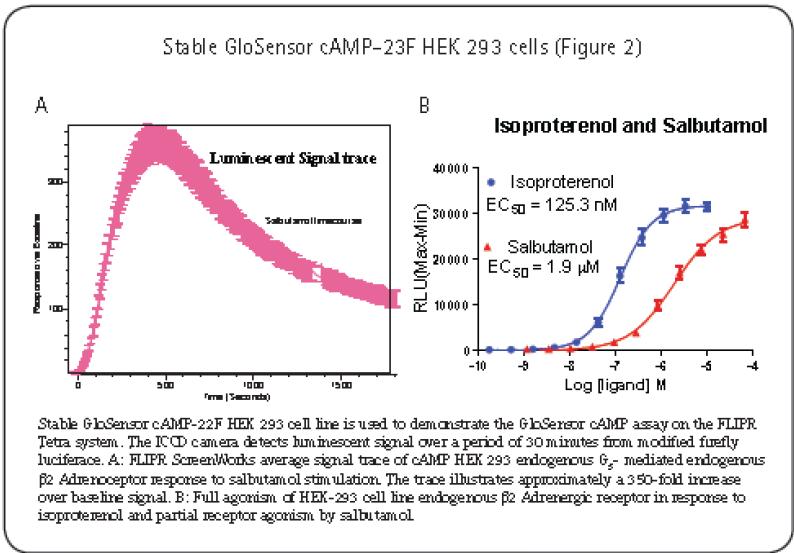
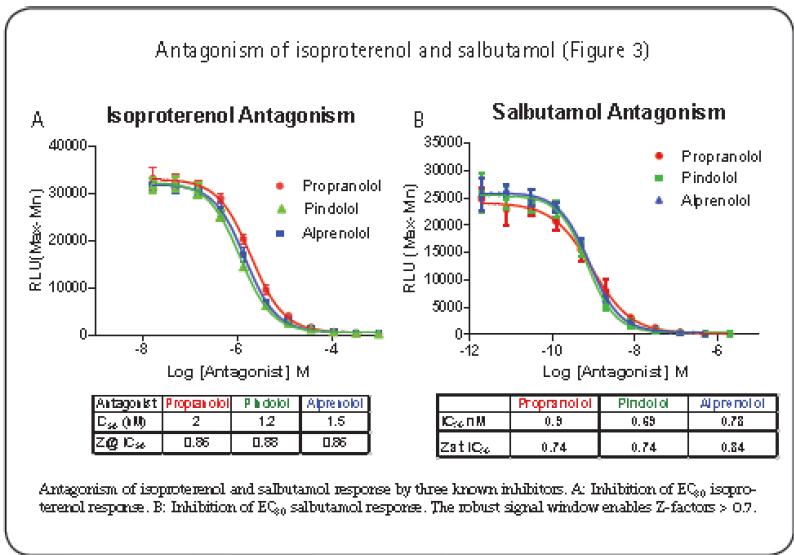
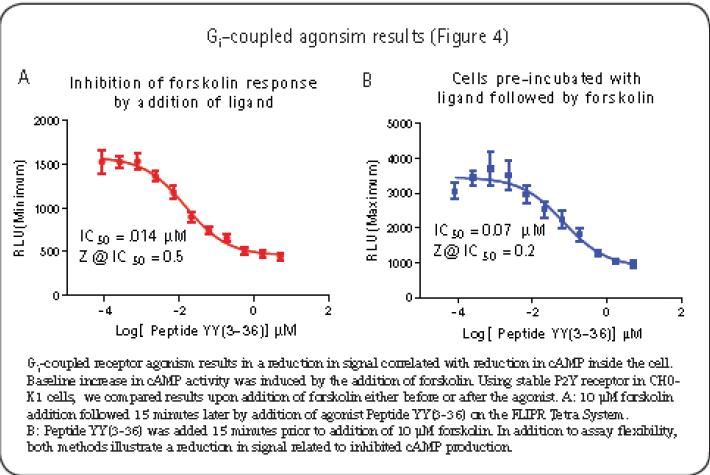
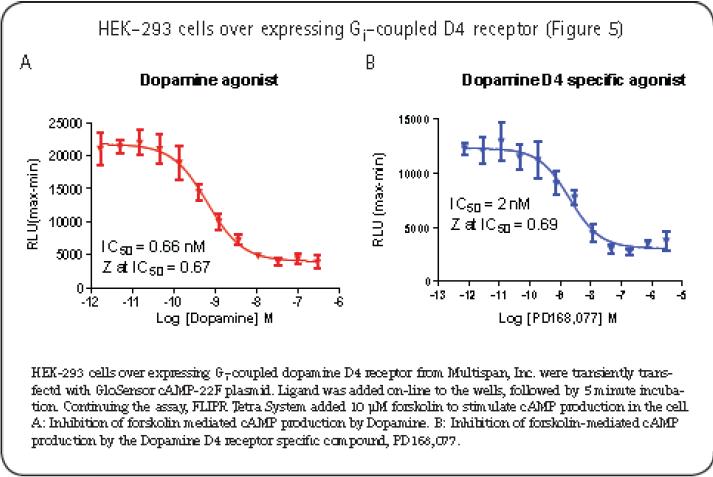
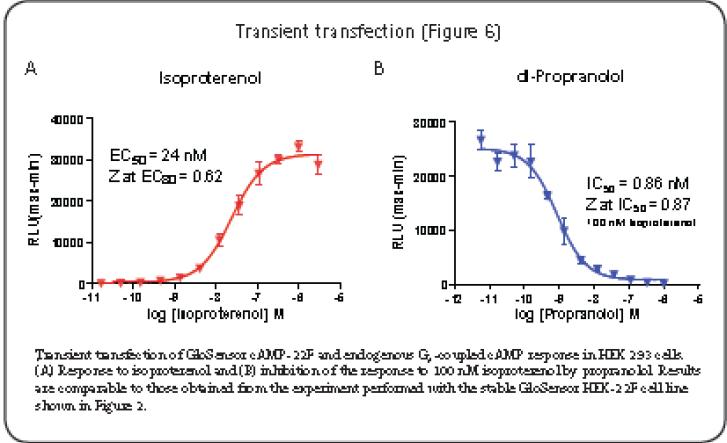
in conclusion:
GloSensorcAMP FLIPRTetra experimental run on the system, for G i - and G s - high-throughput screening applications GPCR receptors coupled to living cells.
Based on FLIPRTetra system The experiments can be performed GloSensor cAMP G i - and G s - coupled GPCR receptors kinetic measurements without the need for end-point detection plate reader.
Through this application note , we show the use of Glosensor cAMP cell line and Glosensor  The experimental method of transfecting cAMP plasmid into endogenous receptor cells is very convenient.
VTM sampling kits are designed for the collection, preservation, and transport of viruses, chlamydia, mycoplasma, and ureaplasma urea. They are now widely used for sampling and transporting prior to virus detection. MandeLab's VTM kits provide a safe and convenient way to collect and transport virus samples.
Nasal swab kit virus sampling tube,Used to collect samples of secretions from the throat or nasal cavity, Disposable
Jiangsu iiLO Biotechnology Co., Ltd. , https://www.sjiilogene.com